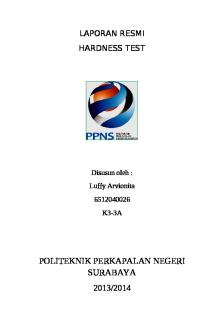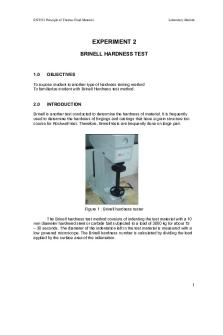Vickers Hardness Testing PDF

| Title | Vickers Hardness Testing |
|---|---|
| Author | Alejandro Hernandez |
| Course | Introduction to Engineering materials |
| Institution | San Diego State University |
| Pages | 9 |
| File Size | 336.5 KB |
| File Type | |
| Total Downloads | 118 |
| Total Views | 149 |
Summary
The purpose of this experiment was to test five materials and determine which of them was most suitable for the production of gears for automobiles...
Description
Objective: The Vickers hardness test mainly serves to measure the hardness of materials, its physical durability. Hardness is defined as a material's “resistance to deformation” (#1) and it can vary depending on the material. For example, the hardness of a standard metal measures its ability to withstand plastic deformation, a phenomenon which irreversibly distorts a material. On the other hand, other materials experience elastic deformation, in which the physical alterations are reversible. The purpose of this experiment was to test five materials and determine which of them was most suitable for the production of gears for automobiles. The ideal hardness for automobile gears was determined to be 500 HV30. The desired hardness value, in this case, was a unitless value of 500 indented with a load of 30 kg for 10-15 seconds. The hypothesis based on the group’s knowledge of material properties was that the Zirconia ceramic and 1018 Cold Rolled Steel would result in the most desired hardness values. Experimental Equipment: Figure 1: Materials
1
Figure 2: Vickers Apparatus
Label A: The purpose of this wheel was to adjust the height of the measuring platform to the diamond indenter. Label B1 and B2: The pedal’s purpose was to initiate the indentation process; the lever was then pushed down to start the inner mechanisms. Label C: This knob was used to focus the microscope. Label D: Eyepiece Label E: This lever was utilized to move the material from the indentation section of the apparatus, underneath the microscope for measurements.
Procedure and Observations: 2
Preliminary Experiment Setup Prior to beginning the Vickers hardness test, there were several crucial steps that needed to be handled in order to successfully complete the procedure. The group needed to make sure that the machine’s power outlet was correctly set up and an indentation force of 30 kg was correctly loaded. In addition, anyone with long hair was required to tie it up and loose apparel was prohibited to prevent safety hazards.
Steps: 1. The sample was placed underneath the diamond indenter. 2. Using the wheel (Label A) the sample’s height was adjusted in relation to the indenter. The ideal height to the indenter was as close as possible, however not touching. 3. The Vickers hardness began once the pedal (Label B2) was pressed and the small lever (Label B1) was pushed down. 4. Once the indentation process was complete, the sample was then relocated below the microscope utilizing the larger lever (Label E). 5. The indentation was located using the microscope. The left and right knobs beside the microscope were used accordingly to adjust the scale and quality of the indent. 6. The first indentation side was measured and the second side was also measured by rotating the microscope 90 degrees. Both measurements were in micrometers.
Experimental error 3
Before beginning the experiment, it was important to understand that every measurement was bound to have uncertainty. Since the measuring device within the Vickers apparatus only provided three significant figures, all measurements had an uncertainty of ± 0.5 microns, which was equivalent to ± 0.0005 millimeters. In addition, prior to beginning the experiment an assumption was formed, that the Vickers apparatus was properly calibrated. This assumption was a factor in the measurement error. Another possible source of error was operator inexperience and inaccurate performance while measuring indentations. For most groups, it was the first instance any individual had performed the Vickers hardness test. It was possible that while measuring the indentation, the scale and quality of the view was inadequately adjusted, which thus led to inaccurate measurements. The Vickers hardness test was highly dependent upon the individual’s ability to measure indentations correctly. For these reasons, the operator and machine calibration were two feasible sources of measurement error. As mentioned previously, every test measurement was correlated with an uncertainty of ± 0.5 microns. However, the uncertainty value changed once the average measurement and hardness value was calculated. The average uncertainty was calculated using the following equation: d (0.0005 mm) … …+(¿¿ 2 δ )2 … Average d ± δ= √¿ 2
The number of uncertainties utilized in the equation was dependent upon the number of total measurements of a material. The equation which was utilized to calculate the hardness value uncertainties will be provided in the Data and Results section.
4
Data and Results: Table 1: Vickers Hardness Raw Data
Vickers Hardness Testing Lab Material 6061-T6 Aluminum 1018 Cold Rolled
Vickers Indentation Size for 30 kg Indentation Load 1st test 2nd test 3rd test
Average
HV30
d1 ± δ1 d2 ± δ2 d1 ± δ1 d2 ± δ2 d1 ± δ1 d2 ± δ2
d±δ
HV ± δ
735
724
747
728
734
103
444
555
480
469
487
235
660
660
832
847
728
105
833
836
834
840
836
80
263
295
233
266
254
860
Steel 360 Half Hard Brass Alloy 110 Copper Zirconia (ZrO2 )
678
702
ceramic
Figure 4: Average and Hardness Value Uncertainties
Avg ±δ
± 1 mm ± 1 mm ± 1.2 mm ± 1 mm ± 1 mm
HV30 ±δ
± .282 ± 1,026 ± .388 ± .191 ± 7,520
Figure 3: Indentation Depths
5
Micrometers
Vickers hardness measurements 900 800 700 600 500 400 300 200 100 0
6 -T 61 0 6
um Al
um in
18 10
ld Co
d lle Ro
l ee St
0 36
lf Ha
rd Ha
a Br
y lo Al s s
0 11
er pp Co rc Zi
ia on
ra ce
m
ic
Material Measurement 1
Measurement 2
Measurement 3
Measurement 4
Measurement 5
Measurement 6
HV
Hardness Value 1000 900 800 700 600 500 400 300 200 100 0
860
235 103
105
80
Material Hardness Value
Figure 4: Hardness Value Scatter Plot
Equations:
Average Depth Measurement: D=
d 1 +d 2 2
Hardness Value: HV =1.854 ×
F d2
Clarification of results: 6
The uncertainty for the hardness value was calculated with the following equation:
Hardness Value
(0.0005 mm) −111.24 ׿ 3 (d1) ¿ 0.0005 mm −111.24 ×(¿) ( d 2) 3 ¿ ¿ ± δ =√ ¿
The d input values which were used for this equation correspond to all of the individual measurements of each sample.
Discussion and Results: After concluding the experiment, it was determined that the group’s initial hypothesis was accurate. The 1018 Cold Rolled Steel and Zirconia ceramic yielded the highest hardness values. It was interesting to note that these samples also resulted in the highest HV uncertainties by an exponential margin, both were calculated to have four significant figure uncertainties. This was explained by the correlation between the indentation depths and the precision of the measurements. It was surmised that because the Vickers apparatus only measured up to three significant figures, a lower value measurement resulted in a larger margin of uncertainty. In this experiment, high uncertainties for the hardest samples were the result of the imprecision of the microscope [#2]. The Zirconia ceramic was by far the hardest material tested, with an HV value 3.5 times greater than the steels HV value. After analyzing Figures 3 and 4, it was found that samples such as 110 Copper which had greater indentation depths led to lower HV values and samples such as Zirconia ceramic with lower indentation depths resulted in higher HV values. In retrospect, this result was reasonable because oxide ceramics and steels are materials that are generally favored 7
over others when it comes to the construction or manufacturing of durable products such as automobile parts. For instance, ceramics are materials with a number of useful properties. They have a high scratch hardness and are resistant to crack propagation. The principle of scratch hardness constitutes a materials ability to resist a force on its underlying layers, this force would be applied by a harder material such as a diamond indenter. Similarly, crack propagation occurs when sufficient stress is applied to a material, which then leads to what is known as “microseparations” along the primary fissure [#4]. In addition, ceramics also benefit from a high thermal expansion which allows them to integrate with metals such as steels. These integrations reinforce ductile metal matrixes and form composites with improved mechanical properties. On the other hand, a material such as copper in its pure form is known to be naturally soft because of its large crystal grains in its atomic structure [#3]. Conclusion: The purpose of this experiment was to determine which of the five materials tested was most suitable for the production of 500 HV30 automobile gears. After careful experimentation, calculations and analyzing it was concluded that the material known as Zirconia ceramic was the best option for the production of automobile gears. This material not only surpassed the minimum hardness value of 500 HV30, but it also possessed the best mechanical properties for gear production. An automobile gear must be resistant to every type of stress, whether superficial or microscopic. The Zirconia ceramic provides that resistance and thus was the most qualified material for the production of automobile gears.
8
9...
Similar Free PDFs

Vickers Hardness Testing
- 9 Pages

Härteprüfung nach Vickers
- 4 Pages

254801449-Dureza-Vickers
- 6 Pages

RM - ENSAYO DE DUREZA VICKERS
- 5 Pages

laporan uji bahan hardness test
- 8 Pages

Lab 1 - Brinell Hardness Test
- 15 Pages

Manual de Hidraulica Industrial Vickers
- 301 Pages

Brinell Hardness Test Lab #1
- 6 Pages

Uji Kekerasan Vickers dan Rockwell
- 44 Pages

In-person lab water hardness
- 5 Pages

EXPERIMENT 3 HARDNESS TEST
- 8 Pages

Water Hardness Lab Report
- 5 Pages

E2- Brinell Hardness TEST
- 5 Pages
Popular Institutions
- Tinajero National High School - Annex
- Politeknik Caltex Riau
- Yokohama City University
- SGT University
- University of Al-Qadisiyah
- Divine Word College of Vigan
- Techniek College Rotterdam
- Universidade de Santiago
- Universiti Teknologi MARA Cawangan Johor Kampus Pasir Gudang
- Poltekkes Kemenkes Yogyakarta
- Baguio City National High School
- Colegio san marcos
- preparatoria uno
- Centro de Bachillerato Tecnológico Industrial y de Servicios No. 107
- Dalian Maritime University
- Quang Trung Secondary School
- Colegio Tecnológico en Informática
- Corporación Regional de Educación Superior
- Grupo CEDVA
- Dar Al Uloom University
- Centro de Estudios Preuniversitarios de la Universidad Nacional de Ingeniería
- 上智大学
- Aakash International School, Nuna Majara
- San Felipe Neri Catholic School
- Kang Chiao International School - New Taipei City
- Misamis Occidental National High School
- Institución Educativa Escuela Normal Juan Ladrilleros
- Kolehiyo ng Pantukan
- Batanes State College
- Instituto Continental
- Sekolah Menengah Kejuruan Kesehatan Kaltara (Tarakan)
- Colegio de La Inmaculada Concepcion - Cebu


